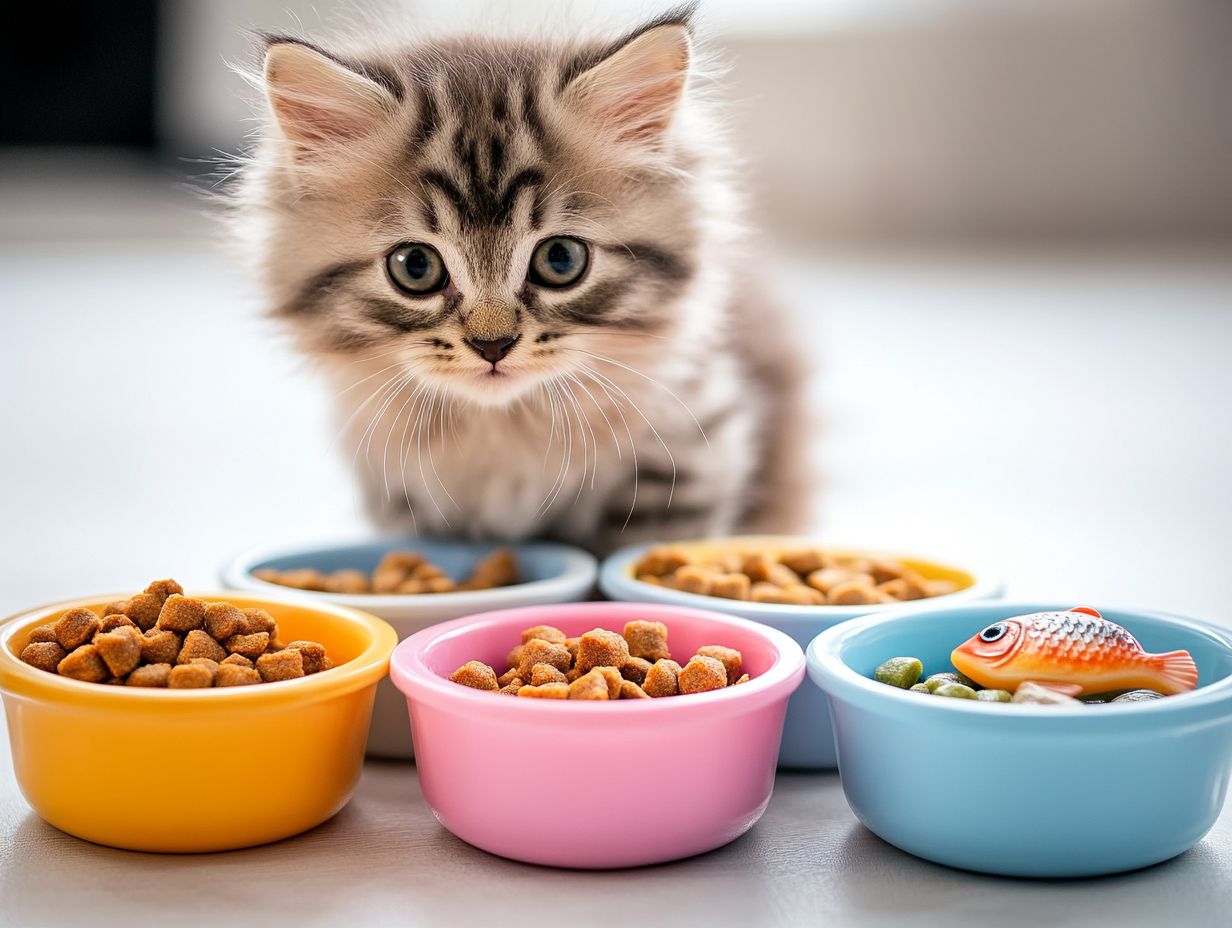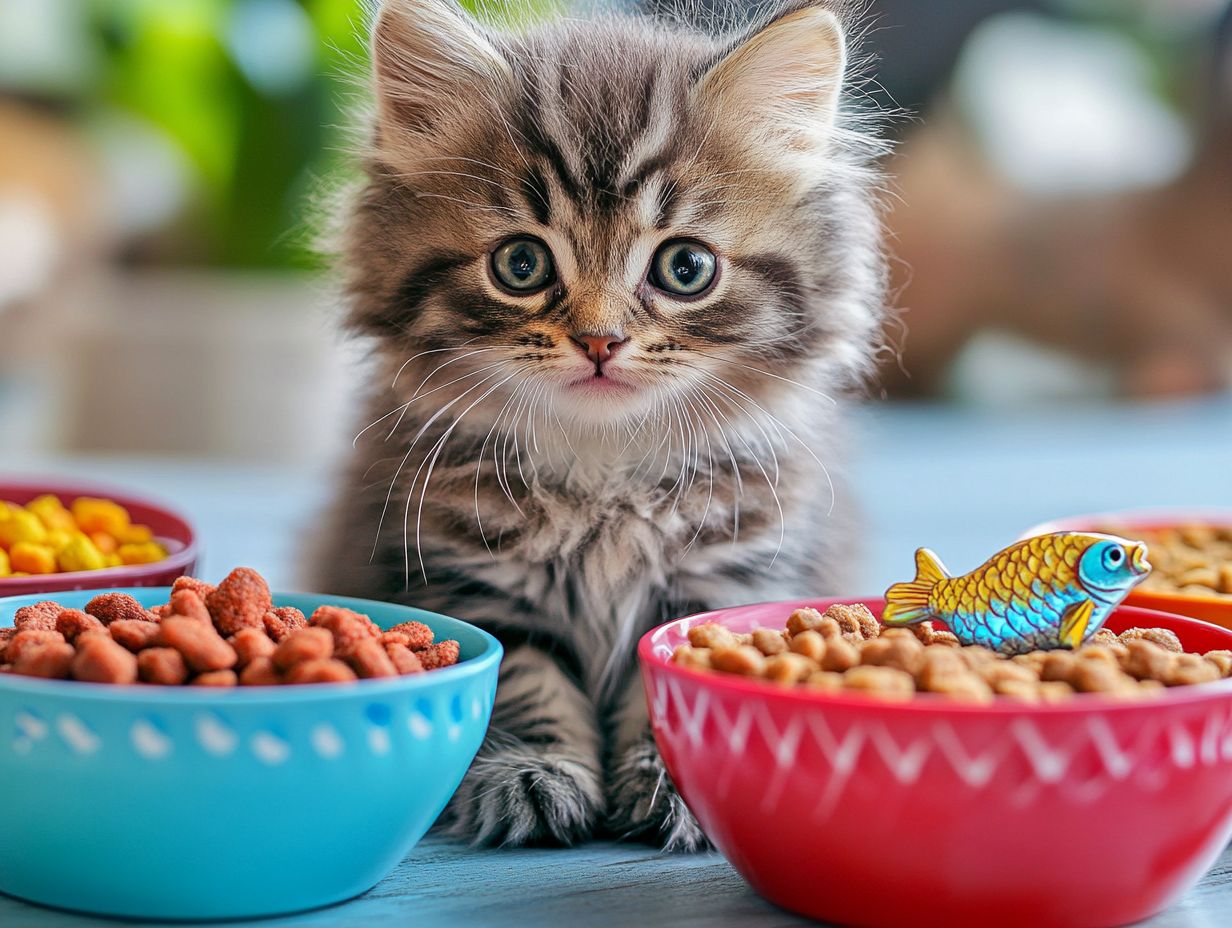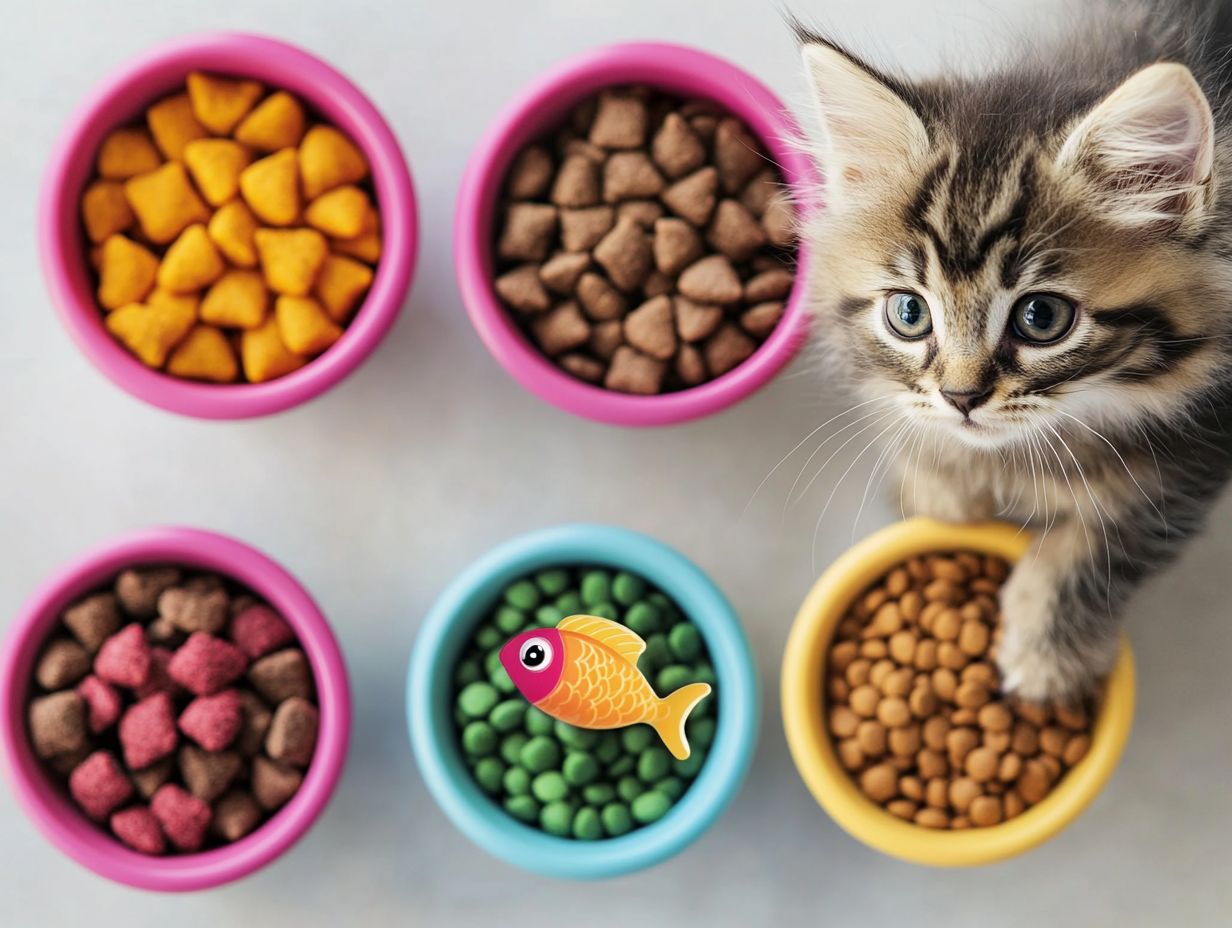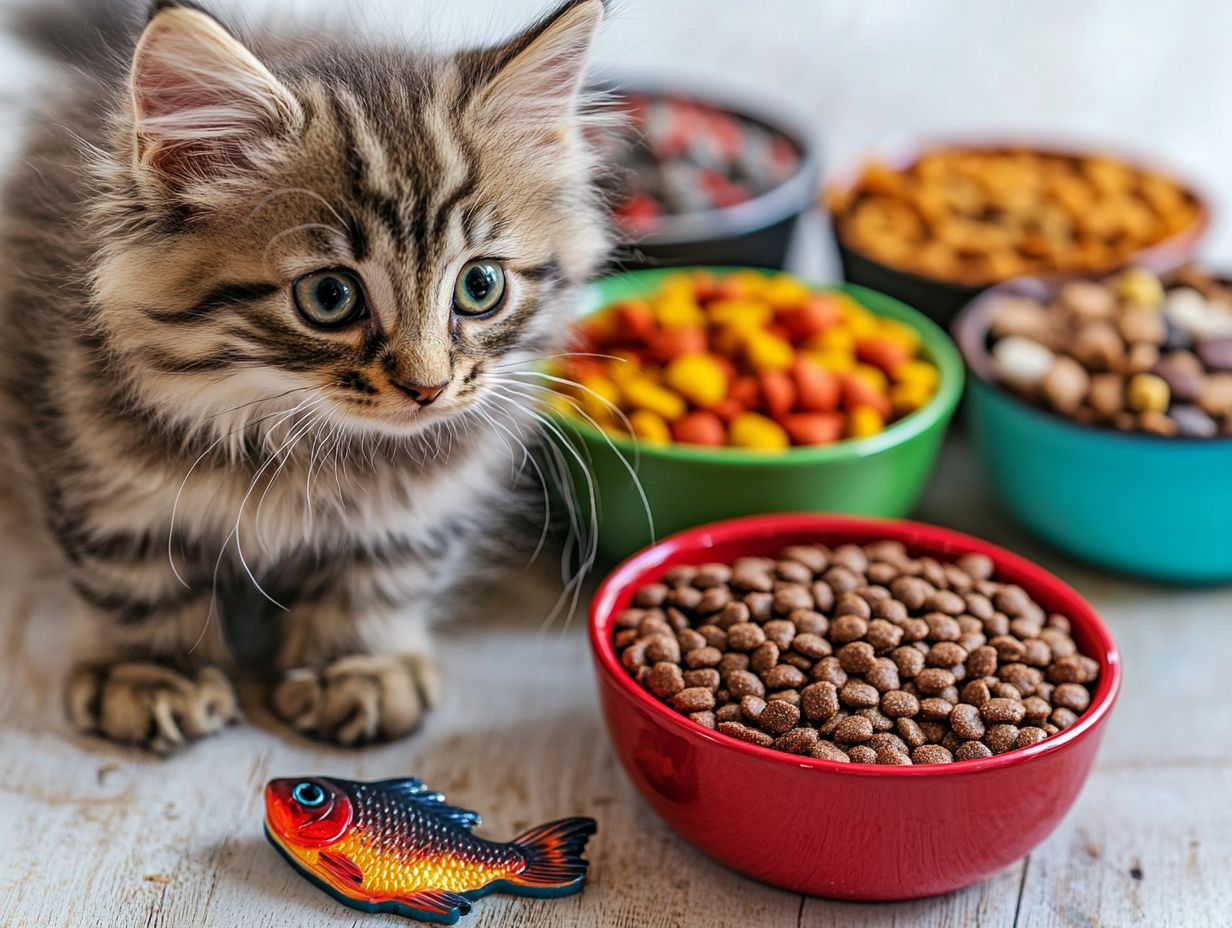Kittens can be notoriously finicky eaters, leaving many cat owners puzzled and frustrated.
Understanding why your little furball turns their nose up at certain kitten food is key to finding the right diet.
This article explores the reasons behind these picky eating habits, what to look for in kitten food, and how to introduce new flavors and textures in a way that excites their palate.
From top-rated commercial options to nutritious homemade food recipes, we cover everything you need to ensure your kitten thrives, even if they are a bit choosy.
Get ready to transform mealtime into a delightful experience for your fussy feline!
Key Takeaways:

- Serve kitten foods that meet their nutritional needs and avoid certain artificial flavors, preservatives, and colors that may pose health risks.
- Introduce new foods to fussy kittens gradually and use positive reinforcement techniques to encourage them to try new flavors.
- Consider homemade kitten food options to ensure your picky eater is getting proper cat nutrition and consult with a veterinarian for advice on supplements and diet changes.
- Be mindful of your kitten’s growth stage and adjust their diet accordingly as they transition from kittenhood to adulthood.
- Consult your veterinarian to address any special dietary needs, especially if your kitten has health conditions like dental disease or gastrointestinal disorders.
Why Are Kittens Picky Eaters?
Kittens are known for being picky eaters, often showcasing unique food preferences that can puzzle their owners. Their finicky eating habits can be attributed to several factors, including the nutritional composition of their diet, the flavors and textures of the food, and even their early exposure to various types of cat food.
Understanding the reasons behind a kitten’s selective eating is essential for ensuring they receive the necessary animal proteins and water for proper growth and health.
What Are The Reasons Behind A Kitten’s Finicky Eating Habits?
Several factors can contribute to a kitten’s picky eating habits, including dental disease, pancreatitis, exposure to different tastes and textures, and the presence of food additives in their food.
One often-overlooked factor is dental disease, which can cause pain while chewing, making certain foods undesirable. For instance, a kitten with inflamed gums may unintentionally avoid kibble in favor of softer and more palatable options, potentially leading to nutritional deficiencies.
Additionally, additives like artificial flavors and preservatives may attract some kittens while repelling others, depending on their individual sensitivities. In severe cases, inflammatory bowel disease can drastically change a kitten’s dietary preferences, causing them to refuse foods they once enjoyed.
A study indicated that nearly 30% of kittens with gastrointestinal disorders experienced a significant decrease in appetite, highlighting the impact of health-related factors on food refusal.
What Should You Look For In A Kitten Food?
Choosing the best kitten food involves considering the unique nutritional needs of kittens, including high-quality, species-appropriate ingredients, appropriate moisture content, and the absence of harmful additives. Kittens require food made from balanced ingredients that provide a mix of nutrients to meet their energy requirements and support healthy development.
What Are The Nutritional Needs Of Kittens?
Kittens have specific nutritional needs that are crucial for their growth and overall health. Their diet should be rich in high-quality animal protein to support rapid growth, muscle development, and energy levels.
Essential fatty acids are also vital for brain development and maintaining a healthy coat. Proper hydration is important, so fresh water should always be available, as it is essential for digestion and kidney function.
The consistency of food is another important factor; soft, easily chewable foods can encourage eating, especially during the teething period.
Lastly, a balanced diet that includes essential vitamins and minerals not only fuels their physical growth but also lays the foundation for long-term wellness, helping to prevent future health problems as they reach adulthood.
What Are The Ingredients To Avoid In Kitten Food?
When selecting food for kittens, it is essential to know which ingredients to avoid, such as unhealthy food additives, common allergens like grains, and artificial colors that can harm a kitten’s health and food appeal.
- Avoid artificial flavors and preservatives.
- Steer clear of artificial colors.
- Be cautious with common allergens such as grains.
Consult with your veterinarian for specific dietary recommendations tailored to your kitten’s individual needs, especially if considering homemade diets or significant changes.
Proper feeding practices are vital; store food in a cool, dry place, check for spoilage, and introduce new foods gradually to minimize digestive upset.
Managing a kitten’s weight is also crucial. Monitor their growth and consult your veterinarian to ensure they are on a healthy trajectory and to prevent obesity.
These potentially harmful ingredients may trigger various negative reactions, particularly in kittens that are already sensitive or have selective feeding habits. For example, while some cats may have sensitivities to certain grains, not all cats are allergic to them. It’s essential to consult veterinary sources for guidance on dietary choices. Additionally, specific toxic ingredients to avoid in cat food include onion, garlic, and chocolate.
This underscores the importance of conducting a thorough analysis of food products to assess their safety and nutritional adequacy. While kittens with selective feeding habits may have fewer options, grain-free, naturally preserved, and wholesome ingredient alternatives often result in healthier diets without sacrificing taste or texture. It is crucial to discuss any changes in diet with a veterinarian, especially for kittens who are sensitive or have health issues.
How To Introduce New Foods To Kittens With Selective Feeding Habits?
Introducing new foods to kittens with selective feeding habits can be a challenging process that often involves trial and error to discover each kitten’s preferred flavors and textures. It is also important to ensure that the new food meets AAFCO nutritional standards for kittens to guarantee it provides adequate nutrition.
By offering various types of food during regular feeding times, cat owners can identify the optimal options by observing which foods their kittens consume most eagerly.
What Is The Best Way To Transition A Kitten To A New Food?

The best way to transition a kitten with selective feeding habits to a new food is to do so gradually over several days, allowing their digestive system time to adjust and ensuring they stay hydrated.
During this period, the old food should be mixed with the new food, starting with a small portion of the new diet added to the existing food. Over the course of about a week, the proportions can be reversed, increasing the amount of new food while decreasing the old food.
It is essential to monitor the kitten’s reactions throughout this process. Their response to the food will indicate whether they are enjoying it or if there are any issues.
By observing their eating patterns and checking for signs of an upset stomach, owners can help ensure that the transition is smooth and positive.
What Are Some Tips To Encourage A Kitten With Selective Feeding Habits To Try New Foods?
Encouraging a kitten with selective feeding habits to try different foods can be achieved by enhancing the appeal of their meals through high moisture content, familiar flavors, varied textures, and attractive presentation and aroma appeal. High moisture content can help reduce the risk of urinary tract issues, which is particularly important for kittens.
Providing high moisture content, such as wet food or broths, ensures that your little feline companion stays properly hydrated during each meal. Incorporating familiar flavors can ease the transition to new foods, making them more palatable.
Offering varied textures, such as a mix of wet and dry food, helps kittens explore new sensations. Changing the presentation of the food—like using bright bowls or spreading kibble in different patterns—can also entice them to try it.
Additionally, warming wet food slightly can enhance its aroma, making it more inviting. These strategies can transform mealtime into an enjoyable adventure for a kitten with selective feeding habits.
What Are Some Popular Kitten Foods For Kittens With Selective Feeding Habits?
Kitten food brands designed for kittens with selective feeding habits cater to the specific preferences of these kittens while also ensuring proper nutrition. As a result, they have become some of the most popular choices among cat owners and veterinarians.
What Are The Top-Rated Kitten Foods According To Experts And Customers?
According to expert opinions and customer reviews, some of the best kitten foods are Smalls, Tiki Cat, Friskies, Nulo, and Blue Buffalo, each offering unique features to cater to the specific needs of kittens with selective feeding habits. These foods are designed to provide essential nutrients that support healthy growth and development during the crucial early months of a cat’s life. For instance, Smalls uses fresh, human-grade ingredients to ensure quality and satisfy a kitten’s natural cravings, earning positive feedback from both pet owners and veterinarians.
Tiki Cat utilizes a formula with high moisture and protein content, which many experts cite as vital for hydration and muscle development. Nulo has gained popularity for its grain-free formula enriched with DHA to promote brain development. These brands adhere to AAFCO or WSAVA guidelines to validate their appropriateness for kittens.
In a recent survey, 87% of customers reported that their cats experienced a significant increase in energy and overall health after switching to these premium brands.
What Are The Unique Features Of Each Recommended Kitten Food?
Each of the recommended kitten foods features special attributes designed for kittens with selective feeding habits. Smalls uses human-grade ingredients, while Tiki Cat offers a variety of high-moisture, flavorful options.
It’s also vital to be aware of the variations in dietary needs for different life stages, including the need for additional nutrients for pregnant or nursing cats. Additionally, potential nutritional deficiencies in raw or homemade diets should be discussed with a veterinarian or a pet nutritionist to ensure balanced diet formulations.
Finally, proper storage of both wet and dry food is essential to prevent spoilage and maintain nutritional integrity.
For instance, Smalls takes pride in using only high-quality animal protein sources, ensuring a high protein content of at least 30% that even discerning eaters will enjoy. Tiki Cat is renowned for its gourmet recipes that combine ingredients like tuna and chicken in rich sauces, providing both texture and hydration. Pet owners should consult with their veterinarian before choosing a diet, especially if considering homemade options.
Nulo’s grain-free formula is enriched with DHA to promote brain development, while Blue Buffalo includes high-quality ingredients free from artificial flavors and preservatives.
Each of the recommended kitten foods features special attributes designed for picky eaters. Smalls uses human-grade ingredients, while Tiki Cat offers a variety of high-moisture, flavorful options.
With flavors ranging from savory chicken to delectable salmon, these cat food options appeal to even the fussiest eaters. Additionally, Wellness Complete Health offers a mix of crunchy kibble and tender bites, creating a fun variety of textures for kittens who may prefer one over the other. The inclusion of different flavors and textures ensures these options meet various food preferences.
Each brand uniquely caters to its feline clientele. Popular choices include Wellness CORE and Stella & Chewy’s.
What Are Some Homemade Options For Picky Kitten Eaters?
Homemade meals for picky kittens can be both nutritionally balanced and appealing for owners who wish to avoid commercially manufactured foods. This approach allows for the use of human-grade ingredients tailored to meet the unique preferences and dietary likes of their pets. However, it is crucial to ensure these meals are formulated to include essential nutrients such as taurine, vitamins, and minerals vital for kittens as obligate carnivores. Additionally, food testing laboratories can help ensure that these meals meet all nutritional needs, and consulting with a veterinarian or a pet nutritionist is recommended to avoid potential deficiencies.
What Are The Benefits Of Making Homemade Kitten Food?
Homemade kitten food offers several advantages, including greater control over ingredient quality, assurance of essential nutrient intake, and the ability to cater to a kitten’s unique tastes and preferences. Caregivers can select high-quality protein sources, such as animal protein, which can enhance the kitten’s overall health and vitality. However, it is essential to note that while homemade food can be a suitable alternative when done correctly, it should not universally be considered superior.
By avoiding harmful additives commonly found in commercial options, homemade food provides a safer alternative that promotes long-term well-being. Custom recipes can be tailored to meet individual dietary needs, making them more appealing, especially for picky eaters. It’s important to be aware of common allergens like dairy or certain vegetables and watch for any signs of food intolerance.
Ensuring that these particular eaters enjoy their meals is essential for maintaining their nutritional integrity and addressing potential underlying issues related to food refusal. It is recommended to use reputable veterinary resources to formulate homemade diets correctly.
What Are Some Safe And Nutritious Recipes For Homemade Kitten Food?

Creating safe and nutritious homemade kitten food can be straightforward and involves using ingredients such as cooked chicken, broth, and vegetables, tailored to the appropriate shapes and textures for young cats. However, it is important that the inclusion of ingredients like finely chopped carrots or peas is minimal and safe for cats, focusing primarily on the need for animal proteins.
These homemade meals are made with fresh, high-quality ingredients, offering an excellent source of nutrition for growing kittens while allowing them to explore new flavors. For more information, check out Fussy Felines: Kitten Foods Even Picky Eaters Will Love for reviews and recommendations.
Additionally, molding homemade meals into fun shapes using silicone molds can make mealtime more exciting for picky eaters and cater to their food shape preferences. Proper food storage and handling practices are essential to prevent spoilage and foodborne illnesses.
How To Ensure Your Kitten Is Getting Proper Nutrition Despite Picky Eating?
Ensuring that a picky kitten receives proper nutrition despite its selective eating habits requires careful planning and, potentially, the use of nutritional supplements like taurine, but these should only be used following veterinary advice to maintain health and hydration. Consultation with a veterinarian can help address any specific nutritional needs or underlying issues.
What Are Some Nutritional Supplements To Add To Kitten Food?
Nutritional supplements can enhance a kitten’s diet by providing essential vitamins and minerals that may not be consistently available in a balanced meal. Carefully selected products, such as omega-3 fatty acids, should only be used when advised by a veterinary professional to prevent potential overdoses or imbalances. These supplements can promote healthy skin and coat while addressing potential deficiencies that young cats may encounter. Additionally, feeding times should be consistent to help establish routine.
Probiotics are also beneficial for digestive health, which is particularly important for kittens with sensitive stomachs or conditions like inflammatory bowel disease. Additionally, liquid kitten supplements like Nutri-Stat offer a concentrated source of calories and protein, making them ideal for underweight kittens or those recovering from illness or pancreatitis. For more information on kitten foods that cater to individual dietary needs, check out this relevant resource.
Hydration is equally crucial; for this purpose, PetNC Natural Care offers hydrating drops containing electrolytes to keep kittens refreshed. Each of these options can contribute to ensuring better growth and development during this critical developmental stage. Monitor hydration by observing urine output and stool consistency, and ensure fresh water sources are available alongside food.
How Often Should You Change Your Kitten’s Food To Ensure A Balanced Diet?
Because kittens can have varying dietary preferences, introducing variety in their food, including both dry and wet options, is crucial for ensuring a balanced diet. Gradually transitioning to new foods can help prevent food aversion and stimulate their appetite. It’s important to consider each kitten’s individual preferences and nutritional needs during this critical developmental stage.
Since a kitten’s palate is still developing, balancing flavors and textures, as well as considering moisture content, can significantly influence their eating behavior. Ideally, the frequency of changing a kitten’s food—whether dry or wet—should be gradual. Wait at least 7 to 10 days before introducing a new food to allow their digestive system to adjust. Rapid changes may lead to gastrointestinal upset, which could result in them avoiding new food altogether.
As you try different options, observe signs of enjoyment or rejection, and adjust their diet as needed to keep their meals appealing. Trial and error, along with careful food observations, can help you identify the best cat food options for your kittens, prioritizing high-quality, AAFCO-approved formulations.
What Are Some Tips For Feeding Multiple Kittens With Different Tastes?
Feeding multiple kittens with varying preferences can be a challenging task for cat owners. It requires consideration of each kitten’s individual tastes and nutritional needs while ensuring that all kittens remain properly hydrated and nourished. It is essential to assess each kitten’s dietary needs with a veterinarian, especially regarding any existing health conditions like obesity or diabetes. Conducting food trials can help identify the most suitable food types, whether they are grain-free options, single protein sources, or those with high moisture content.
Frequently Asked Questions
For personalized advice regarding specific diets (e.g., raw vs. commercial diets), it is always best to consult your veterinarian. They can offer guidance tailored to your kittens’ health and dietary requirements. Additionally, be cautious of rapid food changes or improper supplementation, which may lead to gastrointestinal upset or nutritional deficiencies. Always store food properly to ensure safety and freshness, and be vigilant for signs of spoilage, such as discoloration or an off smell.
What are the best kitten foods for picky eaters?
The best kitten foods for picky eaters are those made with high-quality ingredients and a variety of flavors and textures to entice their finicky taste buds. Brands like Friskies, Blue Buffalo, Caru Classics, and Dr. Elsey’s are often recommended; however, these product recommendations are subjective, and it’s advisable to consult with a veterinarian for personalized advice. Additionally, food packaging that preserves freshness can enhance food appeal.
Are there specific ingredients I should look for in kitten food for picky eaters?
Yes, look for kitten foods that have real meat as the first ingredient and avoid those with fillers, by-products, and artificial preservatives or flavors. Natural and recognizable ingredients are more appealing to picky eaters. Consider chemical analysis, which includes understanding ingredient sourcing and nutritional adequacy according to AAFCO standards, to ensure quality.
Should I stick to one brand or flavor of kitten food for my picky feline?
Not necessarily. It’s good to have a rotation of brands and flavors to keep your kitten interested and prevent them from getting bored with the same food. Just make sure to introduce new brands and flavors gradually.
How can I encourage my picky kitten to eat their food?
Try warming up the food, adding a little bit of water to make it more appealing, or hand feeding them. Also, make sure to feed them in a quiet and calm environment to reduce distractions and anxiety. Paying attention to feeding times can also help establish a routine that encourages eating. For tailored feeding strategies, consult with a veterinarian or a pet nutritionist.
Are there any homemade kitten food recipes for picky eaters?
Yes, there are many recipes available online using simple and nutritious ingredients like chicken, fish, and vegetables. However, it’s important to ensure that these recipes are nutritionally balanced and formulated in consultation with a veterinarian. Homemade diets must meet the specific nutritional needs of kittens, including adequate levels of protein, fat, and essential nutrients. Additionally, be aware of the potential risks associated with homemade diets, including nutritional deficiencies, and stress the importance of veterinary guidance.
Are there any kitten foods specifically designed for picky eaters?
Yes, there are some brands that offer kitten foods specifically formulated for picky eaters. These foods usually have a higher palatability and are made with ingredients that are more enticing for picky felines. Open Farm and Weruva are examples of brands that cater to picky eaters with their high-quality and appealing food types.
